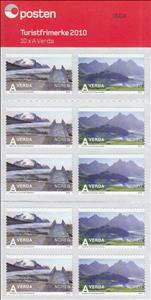Booklet: Tourism route: Helgelandskysten Nord - Lofoten (Norway 2010)
Tourism route: Helgelandskysten Nord - Lofoten (Norway 2010)
16 April (Norway ) within release Landscapes 2010 goes into circulation Booklet Tourism route: Helgelandskysten Nord - Lofoten face value 10*A No Face Value
| Booklet Tourism route: Helgelandskysten Nord - Lofoten in catalogues | |
|---|---|
| Michel: | Mi: NO 1718-1719MH |
Booklet is square format.
Also in the issue Landscapes 2010:
- Booklet - Tourism route: Helgelandskysten Nord - Lofoten face value 10*A;
- Booklet - Tourism route: Sognfjellet face value 10*A;
- Booklet - Tourism routes: Valdresflya - Gamle Strynefjellsveien face value 10*A;
Booklet Tourism route: Helgelandskysten Nord - Lofoten it reflects the thematic directions:
A bridge is a structure built to span physical obstacles without closing the way underneath such as a body of water, valley, or road, for the purpose of providing passage over the obstacle. There are many different designs that each serve a particular purpose and apply to different situations. Designs of bridges vary depending on the function of the bridge, the nature of the terrain where the bridge is constructed and anchored, the material used to make it, and the funds available to build it.
A landscape is the visible features of an area of land, its landforms and how they integrate with natural or man-made features. A landscape includes the physical elements of geophysically defined landforms such as (ice-capped) mountains, hills, water bodies such as rivers, lakes, ponds and the sea, living elements of land cover including indigenous vegetation, human elements including different forms of land use, buildings and structures, and transitory elements such as lighting and weather conditions. Combining both their physical origins and the cultural overlay of human presence, often created over millennia, landscapes reflect a living synthesis of people and place that is vital to local and national identity. The character of a landscape helps define the self-image of the people who inhabit it and a sense of place that differentiates one region from other regions. It is the dynamic backdrop to people’s lives. Landscape can be as varied as farmland, a landscape park, or wilderness. The earth has a vast range of landscapes, including the icy landscapes of polar regions, mountainous landscapes, vast arid desert landscapes, islands and coastal landscapes, densely forested or wooded landscapes including past boreal forests and tropical rainforests, and agricultural landscapes of temperate and tropical regions.


